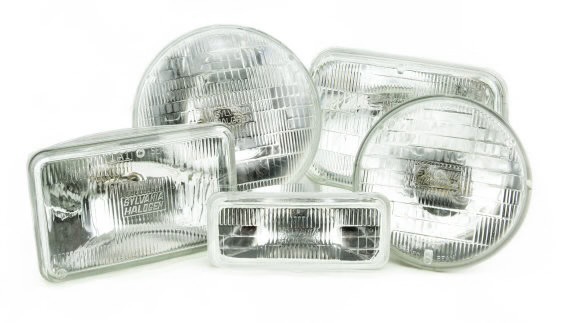- cross-posted to:
- technology@lemmy.world
- technology@beehaw.org
- cross-posted to:
- technology@lemmy.world
- technology@beehaw.org
Despite US dominance in so many different areas of technology, we’re sadly somewhat of a backwater when it comes to car headlamps. It’s been this way for many decades, a result of restrictive federal vehicle regulations that get updated rarely. The latest lights to try to work their way through red tape and onto the road are active-matrix LED lamps, which can shape their beams to avoid blinding oncoming drivers.
From the 1960s, Federal Motor Vehicle Safety Standards allowed for only sealed high- and low-beam headlamps, and as a result, automakers like Mercedes-Benz would sell cars with less capable lighting in North America than it offered to European customers.
A decade ago, this was still the case. In 2014, Audi tried unsuccessfully to bring its new laser high-beam technology to US roads. Developed in the racing crucible that is the 24 Hours of Le Mans, the laser lights illuminate much farther down the road than the high beams of the time, but in this case, the lighting tech had to satisfy both the National Highway Traffic Safety Administration and the Food and Drug Administration, which has regulatory oversight for any laser products.
The good news is that by 2019, laser high beams were finally an available option on US roads, albeit once the power got turned down to reduce their range.
NHTSA’s opposition to advanced lighting tech is not entirely misplaced. Obviously, being able to see far down the road at night is a good thing for a driver. On the other hand, being dazzled or blinded by the bright headlights of an approaching driver is categorically not a good thing. Nor is losing your night vision to the glare of a car (it’s always a pickup) behind you with too-bright lights that fill your mirrors.
This is where active-matrix LED high beams come in, which use clusters of controllable LED pixels. Think of it like a more advanced version of the “auto high beam” function found on many newer cars, which uses a car’s forward-looking sensors to know when to dim the lights and when to leave the high beams on.
Here, sensor data is used much more granularly. Instead of turning off the entire high beam, the car only turns off individual pixels, so the roadway is still illuminated, but a car a few hundred feet up the road won’t be.
Rather than design entirely new headlight clusters for the US, most OEMs’ solution was to offer the hardware here but disable the beam-shaping function—easy to do when it’s just software. But in 2022, NHTSA relented—nine years after Toyota first asked the regulator to reconsider its stance.
It’s not at all clear to me that an actively-shaped beam, which can potentially improperly detect where light should be and blind drivers in that failure scenario, is preferable to simply placing restrictions on how high the light can be.
It’d permit for lights to extend further ahead down the road in some cases, but I have more of an issue with being blinded by headlamps – sometimes non-stock, improperly-mounted ones – than with not being able to see far enough down the road at night.
I bike at night often. Very few turn off their blinders for me. It’s so bad that I have to come to a full stop until the car passes. If you have ever turned off your blinders for bikers at night: Thank you, seriously. We appreciate it more than you know.
That’s the reason I think matrix lights should be outlawed. They allow plausible deniability for the driver. “oh sorry, is my matrix broken?” No, it never worked to begin with; bikes and pedestrians are blinded. Drivers on the opposite lane are blinded if there’s a divider between sensor and lamp. You’re illuminating the town like breaking dawn because your matrix doesn’t care about sleep, either!
And to all the cyclists who use a bright led lamp on their handlebar, remember to also point them down, not straight ahead. I’ve been blinded as a pedestrian and a driver by cyclists who don’t position their lights correctly.
As a cyclist who really tries to point their light downward to not blind others: amen.
My front light is cut off at the top like a car light. No blinding light but the road is VERY well lit ahead.
The light I use on my bike is on that I attach to the handle bar for each use, so it’s not super duper fixed - just meaning I can adjust it on the fly if I need to.
I 100% angle it up and point it right back at cats driving with their high beams on. Almost every time they turn theirs off and I lower my light back down.
I suspect a lot of them now are the automatic high beams that cars absolutely should not have.
Nobody wants it, they just want brighter lights for themselves to compensate for being blinded by the brighter lights of others, but actually to retaliate, nobody can have brighter brights than me!
We’d need regulations for this, which we’d never get, especially after the Chevron doctrine was reversed.
M. A. D.
This exactly. No one would want to pay for in Their vehicles because it doesn’t affect them and would cost extra. Need regulations for this to be implemented.
Also is this even a big safety risk? I understand it’s annoying but does it actually cause accidents?
I know it’s the biggest annoyance I get on the road and the reason I try not to drive at night. And I live in Europe! When I drive at night in north America it’s much worse.
Your low beams were fine 20 years ago. Don’t create this expectation in drivers that they have to turn night into day. That only adds to the problem of asshole drivers prioritizing their ability to see over other people’s ability to see. Matrix headlights are unnecessary and create orders of magnitude more light pollution
Blinding headlights are due to poorly aligned low beams, too bright LED headlights, bigger cars with their headlights mounted higher and higher. So the solutions are: low beam alignment that can’t be made to blind you by the driver, regulation on luminosity and color spectrum of lights, stop financial incentives to make vehicles large, heavier, deadlier.
I just want to see the day where as a pedestrian I don’t feel like my retinas are fried every time a car passes at night or has their brights on during the day (ugh). I know it is wishful thinking because apparently politicians don’t give a shit about pedestrians (or cyclists).
My problem is my state (MI) refuses to enact any kind of road worthy certification process. We have too many trucks and cars with illegal headlights and brake lights. I’ve seen green, blue, purple headlights (mostly modded jeeps) and taillights so tinted I couldn’t see them stopping during the day. And lifted trucks that never reposition their lights so you are blinded no matter what you drive.
We get laws that stop the new tech of active dimming but at the same time we have lazy chicken shit cops that just let these distracting things that are already illegal just slide on by. Might as well buy an import with the good lights or import the parts and install them yourself.
We have too many trucks and cars with illegal headlights
considers
You know, thinking about it…we have traffic speed cameras that automatically detect speeding and issue fines.
It’d probably actually be pretty easy to have a sensor or series of sensors that just sit by a road and detect improperly-mounted headlights. You’re just looking for a vehicle that’s putting out too much light too high up.
You need some poles with light sensors at the appropriate height by the side of the road and a speeding-camera-style thing to grab the license plate. Maybe wait for a series of them to trip as a vehicle is coming down the road, to avoid false positives.
Actually, thinking about it…it’d be even easier than speeding cameras, because you aren’t constrained to stick 'em where people are speeding. Can just put 'em at places like toll booths and such, where you already have someone stopping.
Or have the sensors mounted on the cop cars themselves. So driving by them can trigger an alert, it will give them the ability to confirm the readings or issue a fix it ticket that won’t be an automatic fine unless the person is caught again. Shouldn’t punish people that don’t know their lights are illegal on the first offense.
Nor is losing your night vision to the glare of a car (it’s always a pickup) behind you with too-bright lights that fill your mirrors.
It really fucking is. Nothing is a bigger red flag to me than a pickup. 98% of pickup drivers are assholes.
My catchphrase when driving has become “It’s always a fucking pickup”
My personal one is “Dumb fuck in a truck.”
Controversial, but auto-highbeams should never have existed. Turning on high beams should always be manually triggered by the driver.
Auto high beams have done a pretty OK job at detecting oncoming cars, in my experience. People blasting every fucking house in the neighborhood with high beams at 25mph, on the other hand, is where my ange lies. High beams are for high speed or aggressive slop change, not low speeds.
I am fine using my high beams in neighborhoods because those damn kids come out of nowhere, and the high beams light up more of the road. Black out curtains if it bothers you imo.
Lighting is the determining factor? I think the real problem is speed. With kids coming out of nowhere, people need to drive slower. With some regular low beams you should see plenty, no need to light up the whole neighborhood
Exactly this. If you need more light, fog lights (a wide but flat beam) do wonders in neighborhoods, especially around corners. Sure, I can see some benefit of illuminating the whole body of a person, but their lower half should be sufficient. Quite frankly, if someone can’t see them with low beams, they weren’t going to meaningfully react any faster with high beams. They’re either driving too fast, the pedestrian is stepping out too fast, or the road is too narrow.
It’s wild how this whole post is about the good of other people but my opinion of respecting non-driving people at the same time isn’t as well-received.
My experience is they blind me for a good ~3 seconds until it drops the high beams.
I usually can’t tell the difference in a single oncoming car if they’re auto or manual high beams. So, given how often I know they’re older cars with the manual high beams locked on, maybe I’m not noticing slow autos. Sometimes I can see high beams flicking on and off more frequently than the average driver would, so I assume they auto and have seemed OK. Maybe I’m just too pessimistic about the average driver though and give autos a pass. The few times I’ve driven a Ford with them, they were OK. I beleive I’m very conscientious about high beam use so they were a little delayed for my liking, but I wouldn’t say 3 seconds. Like I’ll watch for light coming over hills and predict the car is coming and be prepared to drop as soon as they appear
The only automatic thing I want in any car is the transmission. Automatic lights have resulted in morons driving without their taillights on.
Whether it’s cars or computers, when things get made “easier” they just let people be dumber.
Nah. The issue is way more complex than that and begins in proper training for drivers and ends in some proper road worthy inspections of vehicles so that they at least have their lights correctly aligned and aimed.
There are no such issues in Europe. Sure, you get the occasional double blink from matrix led system, but I’d take those systems any day of the week over some who just forgot to turn off their high beams or has their lights aimed incorrectly
It seems to me like we didn’t have this problem twenty years ago. If blinding LEDs are the problem, why not just not allow them anymore for headlights? It takes 5 seconds to pop in a new incandescent headlight on cars that have them, and well made ones can last 20+ years depending on the construction. Visibility is good and equivalent to some LEDs with higher end lamps, and it doesn’t create a superbly unnatural light that impairs the other drivers, pedestrians, or nature. It would also reduce light pollution.
On very rare occasion, the progressive step forward, actually looks a lot like the road backwards. It would take a long time to implement, but anything worth doing is worth taking the time to do it right.
Auto sensing technology is going to be more of a glaring headache in 20 years, when you have half of the cars with failing sensors and everyone getting blinded even worse. Adaptive Driving Beams (ADB) are not a solution, it does not properly address the issues of glare, and it will likely only make the problem worse by further removing human interaction from headlight controls.
Visibility is good and equivalent to some LEDs with higher end lamps
No. Not even close. LEDs are blinding because they have such high output. That high output is what makes things visible.
That’s what high beams are for… Cars don’t need to light the dark side of the moon, drivers only need to see the roadway in front of them. Both provide ample illumination, it’s just one allows you to see the color of a zit on a mouse 3 miles away, which is entirely not necessary for safe night driving.
And I was saying that some higher end incandescent lamps are equivalent to some LEDs. I know there are LEDs that far exceed the lumens of traditional lamps.
Which LEDs have you seen that are equivalent to some incandescent lamps?
Last car with LEDs I had, made the road completely visible with the low beams, something which no car with halogens has done for me. It also had an extremely clear cutoff so as not to blind oncoming traffic, whereas many incandescent headlamps have no real cutoff line, so they can actually be more annoying for oncoming traffic.
When I turned on the high beams, they’d automatically black out the parts where there were other cars (both oncoming and ones driving in front of me), while still keeping the sides of the road illuminated much further than low beams would, so if a deer decided to commit sudoku, I’d at least get a heads up. But I was nearly never flashed to drop down to low beams. And I live in a country where everyone knows to flash when they’re being blinded - and to drop to low beams when being flashed.
I can tell you that good visibility has saved me from getting expensive venison more than once. I can also tell you that in any car I’ve had with good low beams, I’ve switched off my high beams exceptionally early when there’s oncoming traffic, so really, there’s LESS glare for other drivers.
All you need is to have all car’s lights be horizontally polarized and then all windshields have a vertical polarizer there I’ve fixed the problem.
Now basically the light would come out and only vertical polarizer light or scattered light would be accepted by everyone’s windshields. If you’ve ever played with this setup on your own using a flashlight and polarizer shades, the color of almost all objects look so cool.
And pedestrians and cyclists?
So long as they are wearing polarized glasses they too can join in on the fun.
Was walking the dogs at five am when I realized the impracticality of this statement. You are suggesting people wear sunglasses at night so automobile drivers don’t have to slow down to a speed safe for the conditions. Just don’t overdrive your headlights so you can safely see and react to anything (cyclists, pedestrians, livestock, rhythm pigs, critters in the road)
Also retrofitting all front and back windshields of all existing vehicles on the road.
It’s practical. The polarizers don’t have to be sunshade just polarizing. There’s a little attenuation but it’s by no means a dark shade. Obviously you are tossing away half the light plus the light Absorbed by the glasses. It can be gradually phased in over the usual 13 years of full fleet replacement.
Half the light plus are functionally sunglasses and would be hazardous for a pedestrian to be wearing in the dark. The only time a pedestrian would be able to see is when a vehicle was illuminating the area.
You could be wearing a flashlight also with a polarizer on it? The street lights could also be made polarized.
I believe you’ve veered into possible but far from practical territory.
Fuck cyclists, pedestrians and residents, I guess.
No, everyone can wear polarizer gear and benefit. But if they didn’t, it would be just like now.
Oh that is such a cool idea! Wouldn’t even need the whole windscreen to be polarized, polarized glasses for the driver should also work.
Thanks I found out about it accidentally looking for ways to control reflections on photos.
I found out about it by being unable to use my laptop with sunnies unless I rotate the sunnies or the screen. Yet another lcd downside, should’ve got an old lmao
The ol’ DMG Gameboy tech.
Also, make sure that all reflectors are turning the polarisation by 90°
A simple regulation can create a standard to establish all the required changes and suddenly you’ll be able to see the road finally.
And finally I will be able to use eye protectors when cycling at night.
Right now, it just increases the lens flare and even getting expensive ones will, at most, not increase lens flare.
Removed by mod
I fucking wish, we rarely get that here in North America. I had that on my old Mazda 3, and fucking loved it. I’d always keep them angled all the way down in the city with well-lit streets and only angle them up on the highway
Removed by mod
You’re right, it’s intended to compensate for extra sag of the rear suspension, but if I don’t need them aimed up then I might as well keep them down so as not to dazzle any oncoming drivers
That requires the driver to actually care
That would need proper training - meaning a drivers license that’s worth the plastic it occupies. Which it isn’t. Compared to the EU, a north American driver’s license is like letting a paper plane flyer in an A380 and saying “There’s the light switch, there’s the Autopilot, go fly”.
This, and the one facing the other side of the road needs to be angled lower than the other one, that’s it.
Removed by mod
I dint think they make those on BMWs, or at least not my neighbors bmw.
Modern BMWs auto-level, so they don’t need manual adjustment.
Based on the one time I’ve driven their electric SUV, they auto level to blast and dazzle the cars in front of me. Together with the GPS that only told you about the offramp you need at the last second, I felt like a serious road hazard.
Never driving that thing again.
Looks like a 2015ish car, would that be modern enough?
I’d just go for a “feature” that disables the on/off function (leaving the momentary function alone) of the hi-beam when a sensor/s detects light above a certain luminosity. I also think an extra cost to the registration could be tacked on for vehicles that are lifted or otherwise have headlights above a certain height that would scale with the said height.
That’s what auto-high-beams do, but it’s always a little too slow.
That is quite a complex task. Being able to focus the beam in a certain direction is one thing. And it is the easier part.
But where should it focus to? You cannot just base the up/down position of the head and therefore the lamp as such, you also need to know where the wearer is looking left or right of the direction of travel. Just imagine you are sitting in a car and a guy with such a headlamp is coming in your direction. All this biker needs to do is just turn his head and look at you for some reason, and blam! You are staring right into a blazing array of LEDs.
Can anyone explain this part to me, like I’m five?
From the 1960s, Federal Motor Vehicle Safety Standards allowed for only sealed high- and low-beam headlamps, and as a result, automakers like Mercedes-Benz would sell cars with less capable lighting in North America than it offered to European customers.
Meaning it legally must be a sealed unit with only 2 states, high and low. In Europe and/or other places there may be multiple angle states and/or strip headlights or other stuff based on their specific regulations. The result is that the efficacy of US headlight systems have a hard upper bound for how effective they can be, based on what was practical to do in the 60s.
Sealed beam headlights are the whole thing, lens, reflector, bulb all in one assembly. You don’t replace the bulb with these, you replace the entire light. Think old cars/trucks when everything had standardized round glass headlights. Not unique designs per model.
Because Mercedes Benz couldn’t use their fancy euro headlights for cars in the US, they had to use the standardized sealed beam lights, which were not as powerful.
















